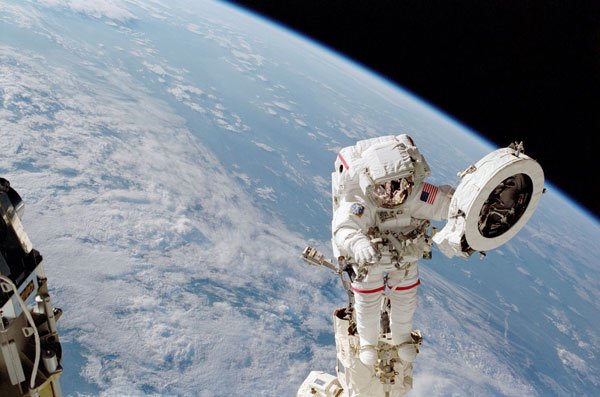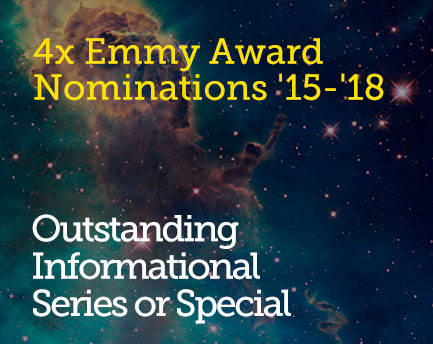April 16, 2014 4:42 pm
Reporting on The Explorers Club Interview with 7-Time NASA Shuttle Astronaut Franklin Chang Diaz

Shown here performing an EVA during STS-111, Dr. Franklin Chang Diaz is tied for the record for most spaceflights – seven! Credit: NASA
Today’s guest post is written by StarTalk Radio’s Social Media Coordinator, Stacey Severn.
Dr. Franklin Chang Diaz was awarded the Buzz Aldrin Quadrennial Space Award at The Explorers Club Annual Dinner March 15 in New York, along with planetary researcher Maria Zuber. Before the dinner, the two were interviewed by Club Fellow and Director Jim Clash as part of his “Exploring Legends” series. This article focuses on Chang Diaz, who chatted about his experiences as an astronaut, Mars, the supposed UFOs spotted on STS-75, plasma rockets and the American Dream.
Chang Diaz is the former Director of NASA’s Advanced Space Propulsion Laboratory at the Johnson Space Center and is credited with the invention of the “Variable Specific Impulse Magnetoplasma Rocket” (VASIMR), an ion engine that could enable human travel to Mars in as little as 39 days versus eight months with chemical rockets. He holds the record for number of space flights – seven – a distinction shared with only one other astronaut, Jerry Ross, who happened to be on the same stage with Clash last spring for an Exploring Legends interview.
Chang Diaz, a PhD from M.I.T., spoke with a gentle voice and an engaging smile, and began the afternoon talking about why he became an astronaut.
“It’s a dream I had since I was seven, and it was triggered by Sputnik. I come from a country that is not known for astronauts. Costa Rica is not a spacefaring nation (chuckles), but as children we were all fascinated by the possibility of flying in space. Two events triggered this. One, of course, was the launch of Sputnik. The other was in 1958 when a U.S. submarine, for the first time, was able to dive in the Northern Pacific and reappear in the North Atlantic. It was the first nuclear-powered submarine, the Nautilus.
“I was told about this by my grandfather, and I thought that it was remarkable. Such a feat had never been done by, could not be possible, by any submarine. But this ship powered by a nuclear reactor was able to do it. And I felt that someday that sort of transformation had to happen to enable humans to explore space. So I came to the United States in 1968 with $50 in my pocket looking for that goal, and in the end it worked out for me. This is the land of opportunity, I believe with all my heart.”
He went on to explain what it was like being a Space Shuttle frequent flyer:
“Going to space multiple times is like dining, and you learn to taste different flavors as you get more proficient and know more about what to expect. The first flight was a sensory overload, and all I wanted to do was not screw up. And then on the second flight, I started seeing more things that I missed the first time, and so on. The third is even more, and as you go further you can appreciate more of what’s in front of you.”

Jim Clash, planetary researcher Maria Zuber, and Franklin Chang Diaz, photographed 3-15-14 by Stacey Severn.
Dr. Chang Diaz talked about STS-75, a mission on which the astronauts released a satellite on long tether from the Space Shuttle. There are several YouTube videos from this mission that piqued the interest of the UFO community.
“There was no UFO. It was very well-identified, so it was not unidentified.
“We did essentially the same experiment that Benjamin Franklin did with his kite – in space. Instead of a kite, we had a satellite; a metallic sphere, loaded with instruments and weighing about 100 pounds, and we released this ball tied by a tether. The tether was an electric wire with insulation, about the size of a shoestring, and 13 miles (20 kilometers) long. It was one heck of a kite!
“A total force on this kite was no more than the weight of a full coffee mug. With such a small force we had to be very careful. Our task was to keep the Shuttle at a safe distance and very carefully unreel our kite. But as it was unreeling, because it is an electrical conductor, it was cutting through the Earth’s magnetic field and creating a gigantic dynamo which produced electric power. When it was fully deployed, it generated 5,000 volts (five kilovolts).
“There was a spark, and that spark severed the tether, and we lost the kite. We had a 20-kilometer-long tether flying in space, and it was straight as an arrow. And that’s what people saw. Everybody thought it was a UFO. Of course it wasn’t – it was a tether! We knew exactly what it was, and it had a satellite at the end. There were no green men or anything like that.”
The topic switched to planetary exploration. Reaching Mars from Earth on a chemical rocket would take 8 months, but Chang Diaz has developed a plasma rocket that, in large form, could get us there in 39 days. His VASIMR engine is due to be flown to the ISS and tested in space in the near future, and he explained how its ion propulsion works.
“There are two components. One is the engine itself, and the other is a power source that enables the engine to work. That’s why I mentioned the topic of the Nautilus. I always kept that in my mind, and it’s fundamental to enable exploration, true exploration of the solar system by humans, by developing nuclear electric power, in a Nautilus way.”
Because of the extreme heat (millions of degrees) needed to create plasma, VASIMR cannot utilize a metal pipe, because it would melt, so it needs a magnetic bottle.
“You have an invisible pipe, a magnetic field. And you take advantage of the properties of a very hot gas (Argon). When it gets hot enough, it becomes electrically charged. We call it a plasma. That’s what the sun and stars are made of. It (the Argon) starts getting to be plasma-like at about 40,000 degrees. Of course, you want to go higher than that.
“Our rocket engine in Houston is a magnetic plasma rocket. There is no chemistry here. We don’t mix liquid hydrogen and liquid oxygen to make heat, as we do with a chemical rocket. We use electrical power to make it hot, the same way you heat your coffee in your microwave oven. Of course, a microwave oven will eventually vaporize your coffee if you don’t take it out soon enough.
“We have fired this rocket 10,000 times in our vacuum chamber in Houston, and we want to test it now in space. So we’re getting ready to do a demo flight on the International Space Station. It’s a rocket that operates at 200 kilowatts, which is very, very powerful. It’s the power of an SUV, for example, but not powerful enough to send humans to Mars.
“Our plan is to take this rocket in various steps in a commercialization plan to start cleaning out all the trash that’s out there in orbit. That’s one of the commercial uses. Eventually we see this as a potential technology to send humans to Mars. But we do need a nuclear reactor, and we are not working on that yet.”
Chang Diaz is familiar with the controversy surrounding nuclear power. On his second flight, STS-34 in 1989, Atlantis carried the Galileo probe to be launched from the Space Shuttle’s payload bay, sending it on its way to Jupiter. Two radioactive plutonium piles (batteries) were transported aboard the Shuttle. Anti-nuclear demonstrators descended on the Kennedy Space Center and threatened to chain themselves to the launch pad. They eventually launched and Galileo went on to Jupiter as planned.
“The nuclear issue is one we have to wrestle with. I’m not saying it’s right or wrong, but we cannot ignore it.
“It’s not a question of sending a reactor that would be live and operating. We would send the reactors in sections, such that none by themselves would be a hazard. The reactor would be assembled far from the Earth, near the Moon, and the ship would be assembled pretty much like ISS over a period of time. There are a lot of details that can and should be discussed, and it may be that the U.S. is not the one that will actually develop the nuclear capability. There are nuclear-capable nations now that have the wherewithal to do it.”
He spoke about our reliance on Russia to get to ISS, and the challenges with what’s going on in Ukraine:
“I think the challenges also bring opportunity because the private sector has always been able to do this. Today we are seeing the birth of commercial space like the birth of air travel, which began in the 1920s, when we got the first contract to carry the mail or develop air transportation.
“Today, people fly reliably, cheaply and privately. The government is involved in the regulation of flight but they don’t build the airplanes. That is all done by the private sector. And we have millions of people in the air at any given moment. I think that’s what we’re going to see happen in the next couple of decades in space. And that, to me, will be the time that we will have arrived.
“NASA will be hopefully thinking about the future, and going into the frontier where it really should be. It shouldn’t be doing launches to lower Earth orbit. That is a waste of their money, your money.”
The Moon first, or straight to Mars?
“When people climb Everest, they don’t go right to the top. They establish camps. We need to go back to the Moon, establish a presence there and learn to work in space, in another world. The Moon is not that far away. We have the technology to go, and let the private sector get involved in providing the transportation, the ability, so that we can learn to work on the Moon. And, in the process, develop the technology to actually go to Mars and keep on going.
“We can go to Mars in an Apollo-type mission. It would be a mission that would be rather fragile, just like Apollo was. It would be very expensive, it would be one mission only and most likely it would not be repeated because it’s unsustainable. We don’t really want to go at it that way. We need to build the ability that is irreversible, that is able to sustain itself. And that requires business to be involved.”
On meeting the late Neil Armstrong:
“One day I was giving a talk to the astronaut corps. We meet every couple of years for an astronaut reunion, and all the old-timers come back. I was giving a talk on my rocket engine research, and after it was over, this guy came over and shook my hand and said, ‘This is great, it’s a great project. Congratulations.’ And it was Neil Armstrong. He just said, ‘I’m Neil Armstrong.’
“Of course I knew what he looked like, but to have him introduce himself to me and shake my hand, I won’t ever forget it. It was amazing. He’s such a humble guy. He’s my hero and all these astronauts from the Moon program and even before were my heroes – and still are.”
Dr. Chang Diaz ended the interview with these thoughts on America:
“I, as an immigrant, think the American dream is the dream of the whole world. Everybody on the planet has dreams, but this country is where you can make them happen. That’s what makes America different. All these folks from other countries come here because they want to make their dreams come true. They want to make their dreams a reality. That’s why I came here.”
Get the most out of StarTalk!
Ad-Free Audio Downloads
Priority Cosmic Queries
Patreon Exclusive AMAs
Signed Books from Neil
Live Streams with Neil
Learn the Meaning of Life
...and much more



 Become a Patron
Become a Patron

